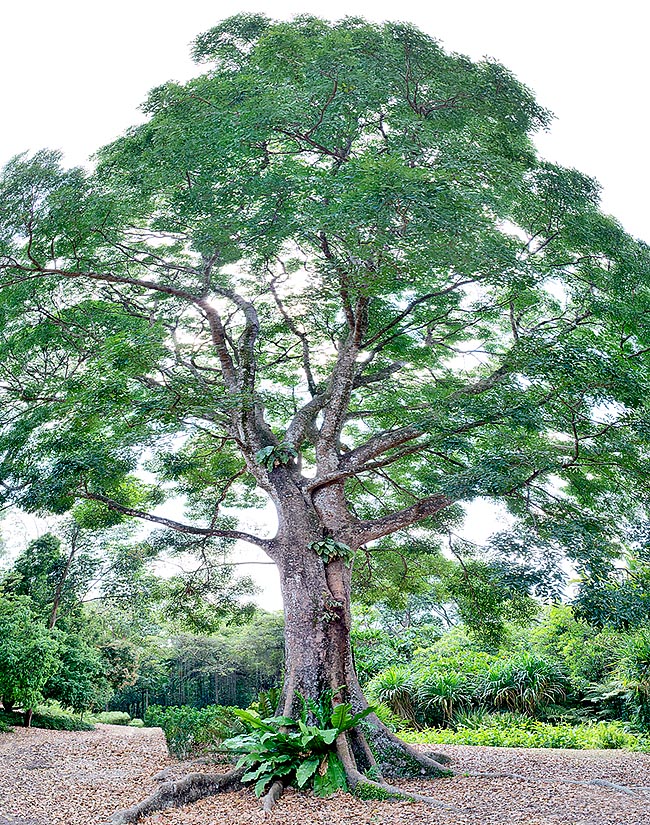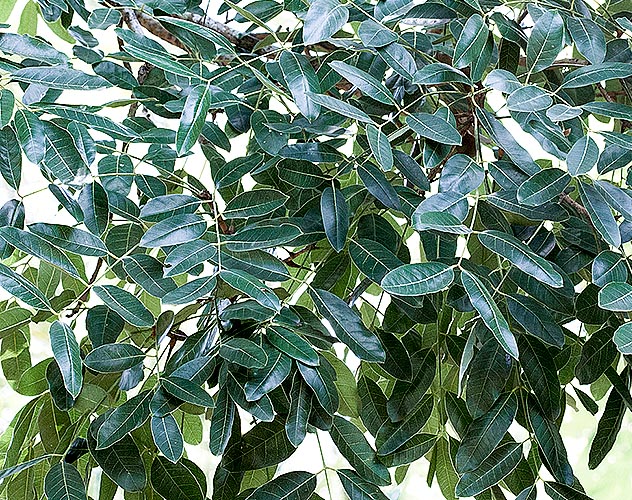Family : Meliaceae

Text © Pietro Puccio

English translation by Mario Beltramini

Native to Central Africa, Khaya senegalensis is a huge tree reaching 30 m of height with tabular roots and massive trunk, 1 m broad. Therapeutic virtues worthing studies. Inserted into the Red List of the IUCN © Giuseppe Mazza
The name of the genus comes from the local one “khaye” of the species; the specific name is the Latin adjective “senegalensis” of Senegal, with reference to one of its origin places.
Common names: african mahogany, dry-zone mahogany, Gambia mahogany, Senegal mahogany (English); acajou du Senegal (French); acaju do Senegal, mogno de Africa (Portuguese).
The Khaya senegalensis (Desv.) A.Juss. (1830) is a monoecious evergreen or semi-deciduous tree, 20-30 m tall, with trunk, of up to about 1 m of diameter, provided at the base of the oldest specimens of short tabular roots (flat roots similar to buttresses), and dark grey bark initially smooth then tending to flake off with the age.
The leaves, spirally arranged in the terminal part of the branches on a 10-20 cm long petiole, are paripinnate, 15-60 cm long, formed by 3-10 pairs of leaflets alternate or sub-opposite oblong-oval with entire margin and shortly pointed apex, coriaceous, of intense green colour above, greyish green below, 5-15 cm long and 3-6 cm broad.
Panicle inflorescences at the axil of the upper leaves, up to about 20 cm long, bearing a crowd of unisexual flowers, present at the same time, of similar appearance, each one with vestigial organs of the other sex, of whitish colour, scented. Calyx with 4 oblong sepals with obtuse apex, about 1 mm long, corolla formed by 4 oblong-obovate petals with obtuse apex, 3-4 mm long, stem tube swollen in the middle (urceolate), 5-6 mm long, with 8 short teeth with obtuse apex and 8 anthers connected to the tube in the inner part. The fruit is an erect globose capsule of greyish colour, woody, of 5-10 cm of diameter, dehiscent from the apex to the base, with four compartments containing numerous almost ellipsoid seeds, about 2,5 cm long and 2 cm broad, flattened, reddish, surrounded by a thin membranaceous wing that facilitates its dispersion through the wind.
It reproduces by seed, that has a short lasting germinability if not duly conserved, previously kept in water for one day, placed just under the surface in organic darining loam maintained humid at the temperature of 24-26 °C, with germination times of 2-3 weeks.

Due to the prized wood this species has ended in the red list of endangered plants © Giuseppe Mazza
It requires full sun, but in the initial phase of growth when it needs a slight shade, and is not particular concerning the soil, though preferring the alluvial ones, deep and draining, acidic to neutral; when adult resists to periods of drought.
The reddish brown wood, relatively hard and heavy, lasting and resistant to the termites, easy to work, is used in the constructions for floors and frames, for boats, inner parts of rail cars and vehicles, furniture, common use articles, artisanal and artistic, in the paper industry, as fuel, with a heating power of about 20 MJ/kg, and in the production of the charcoal.
The leaves are locally employed as fodder. The bark, the flowers and the oil extracted from the seeds are amply utilized in the traditional medicine for various pathologies. Laboratory studies have evidenced in the extracts of the bark the presence of bioactive compounds with antibacterial, antimalarial, antiinflammatory, anthelmintic and insecticide properties that are worth of further investigations.
Due to the excessive and uncontrolled exploitation in many areas its presence has considerably reduced, so much to be inserted into the Red List of the IUCN (International Union for Conservation of Nature) as “Vulnerable” (species at risk of extinction in nature).
Synonym: Swietenia senegalensis Desv. (1792).
→ To appreciate the biodiversity within the MELIACEAE family please click here.
